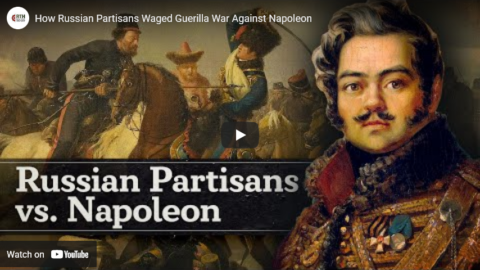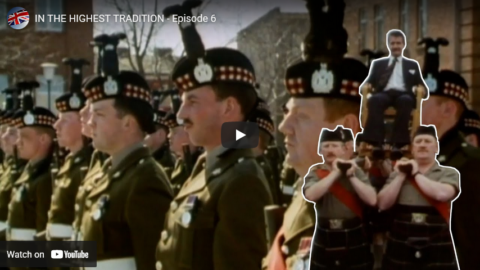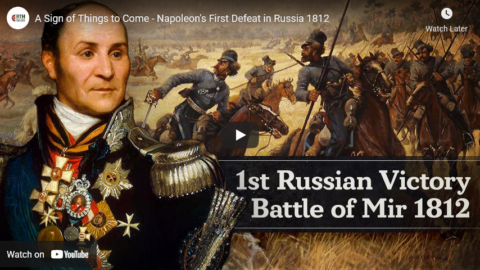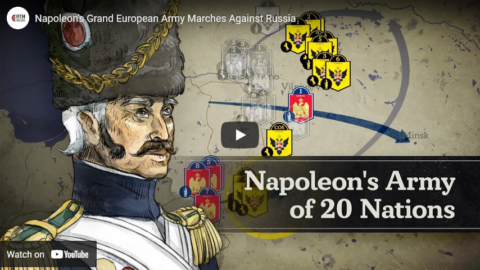PauliosVids
Published 20 Nov 2018Following the 11th Hussars from Hanover to Coburg.
March 9, 2023
Look at Life – The Cherry Pickers (1965)
February 18, 2023
British Empire Crackdown in South Africa – Boer War 1899-1902
The Great War
Published 17 Feb 2023The 2nd Boer War saw the British Empire bring to bear the entire imperial might to put to rest a dispute with the Boer Republics in South Africa. With scorched earth tactics and the use of concentration camps, the Boer War was a glimpse of what was to come in 20th century warfare.
(more…)
February 11, 2023
Tank Chats #167 | French Panhard EBR | The Tank Museum
The Tank Museum
Published 28 Oct 2022How much do you know about the Panhard EBR? Join David Willey for this week’s Tank Chat as he covers the development, design and use of this French armoured car.
(more…)
February 3, 2023
Tank Chats #166 | SOMUA S35 | The Tank Museum
The Tank Museum
Published 14 Oct 2022Join David Willey in this week’s Tank Chat as he details the history of the SOMUA S35, a French cavalry tank of the Second World War.
(more…)
January 11, 2023
Repurposing Obsolete Rifles: The Lebel R35 Carbine
Forgotten Weapons
Published 19 Dec 2017The French military had investigated the possibility of a Lebel carbine in the 1880s, but by the 1930s a different set of priorities was in place. In an effort to make some use of the vast stockpiles of obsolete Lebel rifles France had, a plan was put in place to shorten then into carbines for auxiliary troops like artillery crews and engineers. These men needed some sort of rifle or carbine, but they did not need the best and newest weapons. By giving them shortened Lebel carbines, it would free up more modern rifles like the M34 Berthiers in 7.5mm and the new MAS-36 rifles to go to the front line infantry who needed them most.
The R35 conversion was developed by the Tulle arsenal and adopted in January of 1936. The French government ordered 100,000 to be made, and deliveries began in April of 1937. Production would accelerate and continue right up to the spring of 1940, with a total of about 45,000 being actually delivered before the armistice with Germany. The conversions were all assembled at Tulle, but four other factories manufactured barrels for them: Chatellerault (MAC), St Etienne (MAS), Société Alsacienne de Constructions Mécaniques (SACM), and Manufacture d’Armes de Paris (MAP). These barrels were 450mm long (17.7 inches), and with the similarly shortened magazine tube, the R35 carbines held just 3 rounds. Production would not continue after the liberation of France in 1944.
(more…)
November 28, 2022
QotD: The Carolingian army
In essence, the Carolingian army was an odd sort of layer-cake, in part because it represented a transitional stage from the Germanic tribal levies of the earliest Middle Ages towards to emergence and dominance of the mounted aristocracy of the early part of the High Middle Ages (note: the Middle Ages is a long period, Europe is a big place, and it moves through a lot of military systems; to talk of a single “medieval European system” is almost always a dangerous over-generalization). The top of the layer-cake consisted of the mounted aristocrats, in basically the same organization as the lords of Rohan discussed above: the great magnates (including the king) maintained retinues of mounted warriors, while smaller (but still significant) landholders might fight as individual cavalrymen, being grouped into the retinues of the great magnates tactically, even if they weren’t subordinate to those magnates politically (although they were often both). These two groups – the mounted magnate with his retinue and the individual mounted warrior – would eventually become the nobility and the knightly class, but in the Carolingian period these social positions were not so clearly formed or rigid yet. We ought to understand that to speak of a Carolingian “knight” (translated for Latin miles, which ironically in classical Latin is more typically used of infantrymen) is not the same, in social consequence, as speaking of a 13th century knight (who might also be described as a miles in the Latin sources).
But below that in the Carolingian system, you have the select levy, relatively undistinguished (read: not noble, but often reasonably well-to-do) men recruited from the smaller farmers and townsfolk. This system itself seems to have derived from an earlier social understanding that all free men (or all free property owning men) held an obligation for military service; Halsall notes in the eighth century the term arimannus (Med. Lat.: army-man) or exercitalis (same meaning) as a term used to denote the class of free landowners on whom the obligation of military service fell in Lombard and later Frankish Northern Italy (the Roman Republic of some ten centuries prior had the same concept, the term for it was assidui). This was, on the continent at least, a part of the system that was in decline by the time of Charlemagne and especially after as the mounted retinues of the great magnates became progressively more important.
We get an interesting picture of this system in Charlemagne’s efforts in the first decades of the 800s to standardize it. Under Charlemagne’s system, productive land was assessed in units of value called mansi and (to simplify a complicated system) every four mansi ought to furnish one soldier for the army (the law makes provisions for holders of even half a mansus, to give a sense of how large a unit it was – evidently some families lived on fractions of a mansus). Families with smaller holdings than four mansi – which must have been most of them – were brigaded together to create a group large enough to be able to equip and furnish one man for the army. These fellows were expected to equip themselves quite well – shield, spear, sword, a helmet and some armor – but not to bring a horse. We should probably also imagine that villages and towns choosing who to send were likely to try to send young men in good shape for the purpose (or at least they were supposed to). Thus this was a draw-up of some fairly high quality infantry with good equipment. That gives it its modern-usage name, the select levy, because it was selected out of the larger free populace.
And I should note what makes these fellows different from the infantry who might often be found in the retinues of later medieval aristocrats is just that – these fellows don’t seem to have been in the retinues of the Carolingian aristocracy. Or at least, Charlemagne doesn’t seem to have imagined them as such. While he expected his local aristocrats to organize this process, he also sent out his royal officials, the missi to oversee the process. This worked poorly, as it turned out – the system never quite ran right (in part, it seems, because no one could decide who was in charge of it, the missi or the local aristocrats) and the decades that followed would see Carolingian and post-Carolingian rulers more and more dependent on their lords and their retinues, while putting fewer and fewer resources into any kind of levy. But Charlemagne’s last-gaps effort is interesting for our purpose because it illustrates how the system was supposed to run, and thus how it might have run (in a very general sense) in the more distant past. In particular, he seems to have imagined the select levy as a force belonging to the king, to be administered by royal officials (as the nation-in-arms infantry armies of the centuries before had been), rather than as an infantry force splintered into various retinues. In practice, the fragmentation of Charlemagne’s empire under his heirs was fatal for any hopes of a centralized army, infantry or otherwise, and probably hastened the demise of the system.
Beneath the select levy there was also the expectation that, should danger reach a given region, all free men would be called upon to defend the local redoubts and fortified settlements. This group is sometimes called the general levy. As you might imagine, the general levy would be of lower average quality and cohesion. It might include the very young and very old – folks who ought not to be picked out for the select levy for that reason – and have a much lower standard of equipment. After all, unlike select levymen, who were being equipped at the expense, potentially, of many households, general levymen were individual farmers, grabbing whatever they could. In practice, the general levy might be expected to defend walls and little else – it was not a field force, but an emergency local defense militia, which might either enhance the select levy (and the retinues of the magnates) or at least hold out until that field army could arrive.
Bret Devereaux, “Collections: The Battle oF Helm’s Deep, Part IV: Men of Rohan”, A Collection of Unmitigated Pedantry, 2020-05-22.
September 21, 2022
Radom’s Vis 35: Poland’s Excellent Automatic Pistol
Forgotten Weapons
Published 9 Feb 2016In the 1920s Poland began looking for a new standard military pistol, and tested a variety of compact .380s. The representative from FN brought along an early iteration of the High Power (along with their other entry) even though it was much too large and heavy to meet the Polish requirements. After a couple iterations of testing, it became clear to the Polish Ordnance officers that the High Power was a much more effective service pistol than the compact guns they had been instructed to look for.
Lo and behold, the ultimate choice was a domestic design based largely on the High Power (a direct deal with FN was not an option after Poland’s relationship with FN had suffered through problems with the wz.28 version of the BAR). Toss in a delay to redesign the early decocking mechanism to satisfy the Cavalry (who didn’t realize that the decocker wasn’t actually meant to be used, but rather to just add another claim to the patent), and by 1935 the pistol was finished and formally adopted.
The Vis 35 is one of the best automatic pistols of WWII in terms of both handling and quality. In total 46,000 were made pre-war for Poland’s military, and German occupation forces built another 300,000+ during the war.
(more…)
September 12, 2022
The Lord of the Rings and Ancient Rome (with Bret Devereaux)
toldinstone
Published 10 Sep 2022In this episode, Dr. Bret Devereaux (the blogger behind “A Collection of Unmitigated Pedantry”) discusses the relationships between fantasy and ancient history – and why historical accuracy matters, even in fiction.
(more…)
May 28, 2022
Modele 1890 Berthier Cuirassier Carbine
Forgotten Weapons
Published 17 Jul 2017http://www.patreon.com/ForgottenWeapons
When the Modele 1890 Berthier carbine was adopted for the French cavalry, the decision was made to produce a special version for the Cuirassier troops. These were the elite heavy cavalry, equipped with steel breastplates and elaborate plumed helmets. They existed in that very brief window where the worlds of Napoleon and the smokeless-powder rifle coexisted.
The armor worn by the Cuirassier required some special adaptations to their firearms, specifically to the stocks. The scaled chinstrap of the helmet interfered with a normal cheek weld to the carbine, so the comb was removed from the stock. The metal buttplate also was a poor match for the metal cuirass, as it was difficult to hold the gun in position to aim. To account for this, a leather buttplate was used on these carbine, which would be much less slippery on armor.
Aside from these changes to the stock, the carbine was identical to the standard 1890 cavalry carbine. A total of 20,000 Cuirassier carbines were made in 1891 at the Chatellerault arsenal, and few survived World War One. By fairly early in 1915 the cavalry units had been repurposed as infantry, and the Cuirassier went into the trenches with the armor and carbines — perhaps better equipped, ironically, than the infantry in the greatcoats, kepis, and with Lebel rifles.
Thanks to Justin for finding this rifle for me!
If you enjoy Forgotten Weapons, check out its sister channel, InRangeTV! http://www.youtube.com/InRangeTVShow
May 26, 2022
Why Napoleon’s Invasion of Russia Imploded in Moscow
Real Time History
Published 25 May 2022Sign up for the CuriosityStream + Nebula Bundle: https://curiositystream.com/realtimeh…
When Napoleon took Moscow, he expected victory over Russia was just a matter of time. But six weeks later he has to flee the city as his entire Russia campaign collapses. The strengthened Russian Army is attacking from three sides, winter is coming and in far away Paris a coup is underway.
» SUPPORT US ON PATREON
https://patreon.com/realtimehistory» THANK YOU TO OUR CO-PRODUCERS
John Ozment, James Darcangelo, Jacob Carter Landt, Thomas Brendan, Kurt Gillies, Scott Deederly, John Belland, Adam Smith, Taylor Allen, Rustem Sharipov, Christoph Wolf, Simen Røste, Marcus Bondura, Ramon Rijkhoek, Theodore Patrick Shannon, Philip Schoffman, Avi Woolf,» SOURCES
Boudon, Jacques-Olivier. Napoléon et la campagne de Russie en 1812. 2021.
Chandler, David. The Campaigns of Napoleon, Volume 1, New York 1966.
Lieven, Dominic. Russia Against Napoleon. 2010.
Maag, Albert. Die Schicksale der Schweizerregimente in Napoleons I. Feldzug nach Russland 1812. 1900.
Rey, Marie-Pierre. L’effroyable tragédie: une nouvelle histoire de la campagne de Russie. 2012.
Zamoyski, Adam. 1812: Napoleon’s Fatal March on Moscow. 2005.» OUR STORE
Website: https://realtimehistory.net»CREDITS
Presented by: Jesse Alexander
Written by: Jesse Alexander
Director: Toni Steller & Florian Wittig
Director of Photography: Toni Steller
Sound: Above Zero
Editing: Toni Steller
Motion Design: Toni Steller
Mixing, Mastering & Sound Design: http://above-zero.com
Digital Maps: Canadian Research and Mapping Association (CRMA)
Research by: Jesse Alexander
Fact checking: Florian WittigChannel Design: Simon Buckmaster
Contains licensed material by getty images
Maps: MapTiler/OpenStreetMap Contributors & GEOlayers3
All rights reserved – Real Time History GmbH 2022
May 7, 2022
Modele 1890 Berthier Cavalry Carbine
Forgotten Weapons
Published 14 Jul 2017Get the shirt here: https://shop.bbtv.com/collections/for…
http://www.patreon.com/ForgottenWeapons
The Berthier was adopted in 1890 as a new repeating rifle for the French cavalry, who were at that time still using single shot Gras carbines. The Lebel rifle had been adopted in 1886 for the infantry, but because of its tube magazine it was not conducive to being shortened into carbine form. Andre Berthier devised a way to combine the basic action of the Lebel with the Mannlicher clip system, resulting in a light and handy repeating carbine.
The majority of these carbines were made in 1890 and 1891, and have full length stocks without any provision for bayonets (since the cavalry already had their sabers). A few more were made between 1900 and 1904, and a final order for 40,000 was placed in 1905, but it is unknown if they were actually built. Total production was either 160,000 or 200,000, depending on that last order.
It was not long into World War One when it became clear that cavalry were not suited to trench warfare, and the French cavalry units were repurposed as infantry. As a result, these cavalry carbines were rebuilt in the 1892 infantry pattern when damaged, and after the war all the surviving examples in original configuration were rebuilt as well. This makes them quite rare today in original form.
If you enjoy Forgotten Weapons, check out its sister channel, InRangeTV! http://www.youtube.com/InRangeTVShow
April 22, 2022
How Russian Partisans Waged Guerilla War Against Napoleon
Real Time History
Published 21 Apr 2022Sign up at https://curiositystream.com/realtimeh… and get Nebula bundled in.
The face of war was changing in 1812. While the Russian Army retreated and left behind scorched earth, Russian partisans took up arms against Napoleon’s troops. They harassed and attacked vital supply lines and we a true menace to the Grande Armée‘s rear.
» SUPPORT US ON PATREON
https://patreon.com/realtimehistory» THANK YOU TO OUR CO-PRODUCERS
John Ozment, James Darcangelo, Jacob Carter Landt, Thomas Brendan, Kurt Gillies, Scott Deederly, John Belland, Adam Smith, Taylor Allen, Rustem Sharipov, Christoph Wolf, Simen Røste, Marcus Bondura, Ramon Rijkhoek, Theodore Patrick Shannon, Philip Schoffman, Avi Woolf,» SOURCES
Boudon, Jacques-Olivier. Napoléon et la campagne de Russie en 1812. 2021.
Chandler, David: The Campaigns of Napoleon, Volume 1, New York. 1966.
Durova, Nadezhda. Cavalry Maiden. Journals of a Female Russian Officer in the Napoleonic Wars. 1990.
Lieven, Dominic. Russia Against Napoleon. 2010.
Mikaberidze, Alexander. “The Lion of the Russian Army”: Life and Military Career of General Prince Peter Bagration 1765-1812. PhD Dissertation, 2003.
Rey, Marie-Pierre. L’effroyable tragédie: une nouvelle histoire de la campagne de Russie. 2012.
Zamoyski, Adam. 1812: Napoleon’s Fatal March on Moscow. 2005.» OUR STORE
Website: https://realtimehistory.net»CREDITS
Presented by: Jesse Alexander
Written by: Jesse Alexander
Director: Toni Steller & Florian Wittig
Director of Photography: Toni Steller
Sound: Above Zero
Editing: Toni Steller
Motion Design: Toni Steller
Mixing, Mastering & Sound Design: http://above-zero.com
Digital Maps: Canadian Research and Mapping Association (CRMA)
Research by: Jesse Alexander
Fact checking: Florian WittigChannel Design: Simon Buckmaster
Contains licensed material by getty images
Maps: MapTiler/OpenStreetMap Contributors & GEOlayers3
All rights reserved – Real Time History GmbH 2022
March 23, 2022
In The Highest Tradition — Episode 6
British Army Documentaries
Published 9 Nov 2021This is the final part of the six-part series which delves into the world of the British Army’s regimental traditions and the stories behind them. This is a world where a Napoleonic Drum Major’s staff remains prized booty, a dog wears campaign medals awarded at Queen Victoria’s command, and snuff is served from a ram called George.
© 1989
This production is for viewing purposes only and should not be reproduced without prior consent.
This film is part of a comprehensive collection of contemporary Military Training programmes and supporting documentation including scripts, storyboards and cue sheets.
All material is stored and archived. World War II and post-war material along with all original film material are held by the Imperial War Museum Film and Video Archive.
March 18, 2022
A Sign of Things to Come – Napoleon’s First Defeat in Russia 1812
Real Time History
Published 17 Mar 2022» SUPPORT US ON PATREON
https://patreon.com/realtimehistoryThe Battle of Mir in 1812 was the first battle of Napoleon’s invasion of Russia. Polish Uhlans ride right into a trap set by Platov’s Cossacks and under the Russian summer sun a cavalry skirmish ensues.
» THANK YOU TO OUR CO-PRODUCERS
John Ozment, James Darcangelo, Jacob Carter Landt, Thomas Brendan, Kurt Gillies, Scott Deederly, John Belland, Adam Smith, Taylor Allen, Rustem Sharipov, Christoph Wolf, Simen Røste, Marcus Bondura, Ramon Rijkhoek, Theodore Patrick Shannon, Philip Schoffman, Avi Woolf,» SOURCES
Boudon, Jacques-Olivier. Napoléon et la campagne de Russie en 1812. 2021.Chandler, David. The Campaigns of Napoleon. 1978.
Dujil, Nicolas. “Les armées russes en 1812”, in Rey, Marie-Pierre and Thierry Lentz, eds. 1812, la campagne de Russie. 2012.
Kagan Frederick. Russia’s Wars with Napoleon 1805-1815. The Military History of Tsarist Russia (NY.: Palgrave, 2002).
Lieven, Dominic. Russia Against Napoleon. 2010.
Mikaberidze, Alexander. “The Lion of the Russian Army”: Life and Military Career of General Prince
Peter Bagration 1765-1812. PhD Dissertation, 2003.
Rey, Marie-Pierre. L’effroyable tragédie : une nouvelle histoire de la campagne de Russie. 2012.
Zamoyski, Adam. 1812: Napoleon’s Fatal March on Moscow. 2005.
[Other Russian-language sources listed on the YouTube description]
» OUR STORE
Website: https://realtimehistory.net»CREDITS
Presented by: Jesse Alexander
Written by: Jesse Alexander
Director: Toni Steller & Florian Wittig
Director of Photography: Toni Steller
Sound: Above Zero
Editing: Toni Steller
Motion Design: Toni Steller
Mixing, Mastering & Sound Design: http://above-zero.com
Digital Maps: Canadian Research and Mapping Association (CRMA)
Research by: Sofia Shirogorova, Jesse Alexander
Fact checking: Florian WittigChannel Design: Simon Buckmaster
Contains licensed material by getty images
Maps: MapTiler/OpenStreetMap Contributors & GEOlayers3
All rights reserved – Real Time History GmbH 2022
March 12, 2022
Napoleon’s Grand European Army Marches Against Russia
Real Time History
Published 11 Mar 2022Get Nebula and CuriosityStream in a great bundle deal: https://curiositystream.com/realtimeh…
When Napoleon marched his Grande Armée into Russia in 1812, he had assembled the biggest army in modern European history. Only half of his troops came from territories of the expanded French Empire. Tens of thousands of troops also came from Poland, Prussia, Austria, and the German States as well as Southern Europe.
» SUPPORT US ON PATREON
https://patreon.com/realtimehistory» THANK YOU TO OUR CO-PRODUCERS
John Ozment, James Darcangelo, Jacob Carter Landt, Thomas Brendan, Kurt Gillies, Scott Deederly, John Belland, Adam Smith, Taylor Allen, Rustem Sharipov, Christoph Wolf, Simen Røste, Marcus Bondura, Ramon Rijkhoek, Theodore Patrick Shannon, Philip Schoffman, Avi Woolf,» SOURCES
Boudon, Jacques-Olivier. Napoléon et la campagne de Russie en 1812. 2021.
Brun, Jean-François. “Le cheval dans la Grande Armée“, Revue historique des armées (249), 2007.
Del Negro, Piero. “Les Italiens dans la Grande Armée. La campagne de Russie et le patriotisme italien“, Revue historique des armées (250), 2008.
Elting, John. Swords Around a Throne: Napoleon’s Grande Armée. 1997.
Lieven, Dominic. Russia Against Napoleon. 2010.
Nieuwazny, Andrzej. “Les Polonais de la Grande Armée“, in Rey, Marie-Pierre and Thierry Lentz, eds. 1812, la campagne de Russie. 2012.
Rey, Marie-Pierre. L’effroyable tragédie: une nouvelle histoire de la campagne de Russie. 2012.
Zamoyski, Adam. 1812: Napoleon’s Fatal March on Moscow. 2005.» OUR STORE
Website: https://realtimehistory.net»CREDITS
Presented by: Jesse Alexander
Written by: Jesse Alexander
Director: Toni Steller & Florian Wittig
Director of Photography: Toni Steller
Sound: Above Zero
Editing: Toni Steller
Motion Design: Toni Steller
Mixing, Mastering & Sound Design: http://above-zero.com
Digital Maps: Canadian Research and Mapping Association (CRMA)
Research by: Jesse Alexander
Fact checking: Florian WittigChannel Design: Simon Buckmaster
Contains licensed material by getty images
Maps: MapTiler/OpenStreetMap Contributors & GEOlayers3
All rights reserved – Real Time History GmbH 2022









